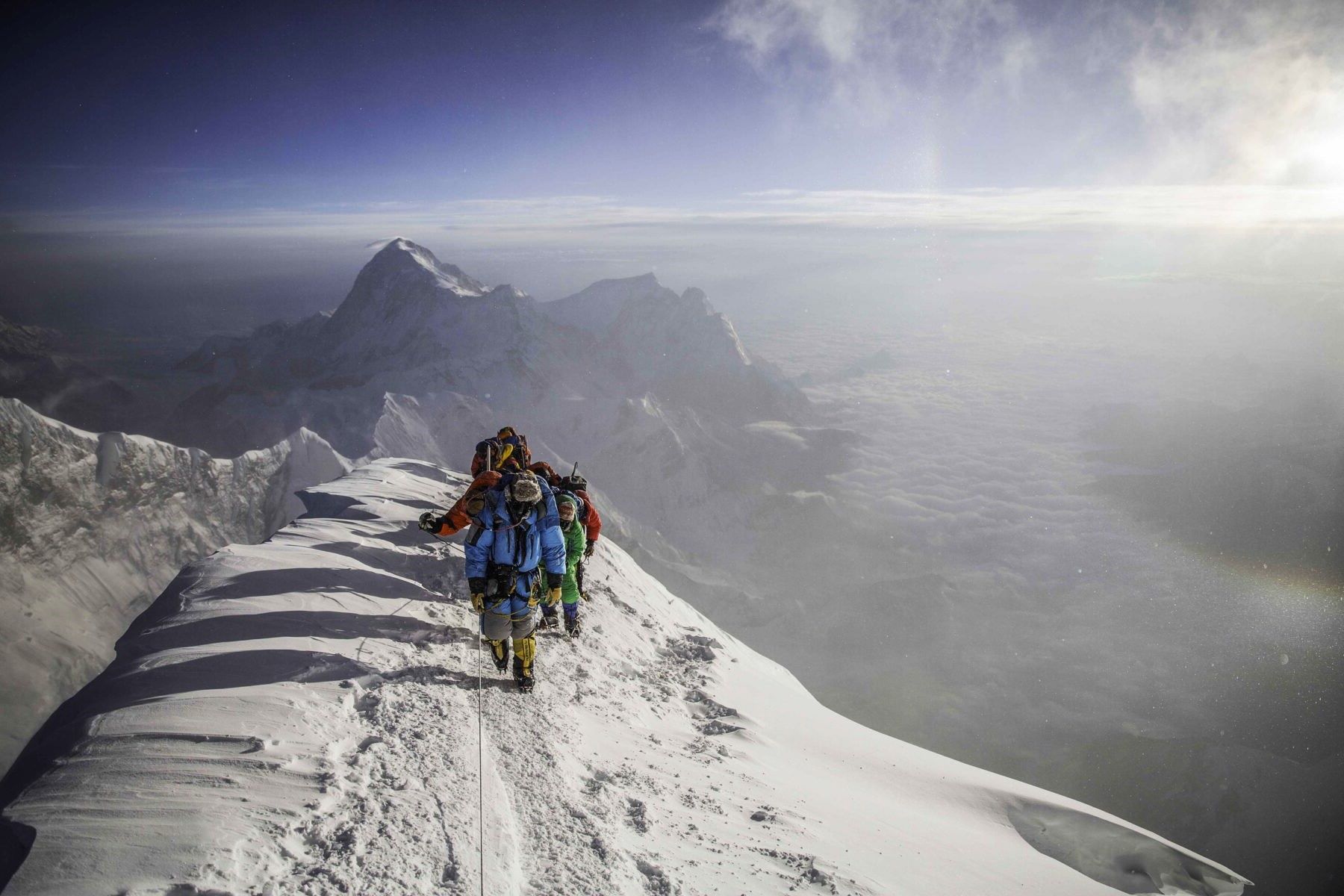Home>Running Paths & Locations>Trail Running>The Incredible Feat Of Kilian Jornet: Running Up Mount Everest


Trail Running
The Incredible Feat Of Kilian Jornet: Running Up Mount Everest
Published: February 27, 2024
Experience the incredible feat of Kilian Jornet as he conquers Mount Everest through trail running, showcasing the ultimate blend of endurance and determination. Follow his awe-inspiring journey now!
(Many of the links in this article redirect to a specific reviewed product. Your purchase of these products through affiliate links helps to generate commission for Therunningadvisor.com, at no extra cost. Learn more)
Table of Contents
The Unbelievable Challenge
Imagine running up the world's tallest mountain, Mount Everest. It sounds like a feat reserved for the realm of fantasy, yet this extraordinary challenge was conquered by none other than the legendary trail runner, Kilian Jornet. His unparalleled achievement in scaling the formidable heights of Mount Everest is a testament to human endurance, determination, and the relentless pursuit of excellence.
The sheer magnitude of this endeavor is awe-inspiring. Mount Everest, standing at a breathtaking 29,029 feet above sea level, presents an imposing obstacle to even the most seasoned mountaineers. The treacherous terrain, extreme weather conditions, and the unforgiving altitude make it a formidable adversary. Yet, Kilian Jornet fearlessly embraced this monumental challenge, defying the limits of what was deemed possible in the realm of trail running.
Jornet's audacious quest to run up Mount Everest represents a convergence of athleticism, courage, and an unwavering spirit of adventure. It embodies the epitome of human potential and the relentless pursuit of pushing boundaries. The sheer audacity of envisioning such a monumental feat and then translating it into reality is a testament to Jornet's indomitable spirit and unyielding determination.
The significance of this incredible achievement extends beyond the realm of sports. It serves as a source of inspiration for individuals across the globe, igniting the flames of ambition and fortitude. Jornet's remarkable feat exemplifies the power of the human will and the capacity to surmount seemingly insurmountable obstacles.
In the annals of trail running history, Kilian Jornet's ascent of Mount Everest stands as a testament to the unyielding human spirit and the relentless pursuit of the extraordinary. It is a saga that transcends the realms of physical prowess and delves into the depths of human resilience and the unquenchable thirst for conquering the impossible.
Kilian Jornet's Unprecedented Achievement
Kilian Jornet's unprecedented achievement in running up Mount Everest stands as a monumental milestone in the realm of trail running and human endurance. The audacity and sheer magnitude of this feat have reverberated across the global trail running community, leaving an indelible mark on the annals of sporting history.
Jornet's ascent of Mount Everest was not merely a physical endeavor; it embodied the convergence of unwavering determination, unparalleled athleticism, and an unyielding spirit of adventure. The sheer audacity of envisioning such a monumental feat and then translating it into reality is a testament to Jornet's indomitable spirit and unyielding determination.
The significance of Jornet's achievement extends far beyond the realm of sports. It serves as a beacon of inspiration, igniting the flames of ambition and fortitude in individuals worldwide. Jornet's remarkable feat exemplifies the power of the human will and the capacity to surmount seemingly insurmountable obstacles.
In the world of trail running, Jornet's ascent of Mount Everest has redefined the boundaries of what was once thought possible. It has shattered preconceived notions and expanded the horizons of human potential. Jornet's unparalleled achievement serves as a testament to the unyielding human spirit and the relentless pursuit of the extraordinary.
The impact of Jornet's unprecedented achievement resonates not only within the trail running community but also within the broader spectrum of human achievement. It stands as a testament to the indomitable nature of the human spirit and the relentless pursuit of pushing the boundaries of what is deemed achievable.
Kilian Jornet's ascent of Mount Everest stands as a testament to the unyielding human spirit and the relentless pursuit of the extraordinary. It is a saga that transcends the realms of physical prowess and delves into the depths of human resilience and the unquenchable thirst for conquering the impossible.
The Physical and Mental Demands of Running up Mount Everest
Embarking on the monumental challenge of running up Mount Everest entails confronting an array of unparalleled physical and mental demands. The sheer altitude of the world's tallest peak presents an extraordinary test of human endurance. At an elevation of 29,029 feet above sea level, the human body is subjected to oxygen levels that are significantly lower than those at sea level. This drastic reduction in oxygen availability poses a formidable challenge to the cardiovascular and respiratory systems, necessitating an exceptional level of physical preparedness.
The extreme altitude also gives rise to a myriad of physiological adaptations within the body. As the air thins and the oxygen levels plummet, the body undergoes a series of complex adjustments to cope with the diminished oxygen supply. These adaptations include an increase in the production of red blood cells to enhance oxygen-carrying capacity, as well as heightened respiratory rates to compensate for the reduced oxygen pressure. However, despite these remarkable physiological adaptations, the human body is pushed to its limits in the rarefied air of Mount Everest.
In addition to the formidable physical demands, the mental fortitude required to undertake such a monumental feat cannot be overstated. The psychological challenges inherent in running up Mount Everest are as daunting as the physical obstacles. Enduring the relentless mental strain of navigating treacherous terrain, battling extreme weather conditions, and confronting the inherent risks of high-altitude mountaineering demands an unwavering resolve and an unyielding spirit.
The mental resilience required to confront the formidable heights of Mount Everest is a testament to the extraordinary strength of the human mind. It necessitates a profound capacity to endure discomfort, overcome fear, and persist in the face of adversity. The mental demands of running up Mount Everest encompass a relentless determination, an unshakable focus, and an unwavering belief in one's ability to conquer the seemingly insurmountable.
In essence, the physical and mental demands of running up Mount Everest transcend the realms of ordinary human achievement. They epitomize the extraordinary capacity of the human spirit to surmount unparalleled challenges and conquer the most formidable of obstacles. Kilian Jornet's unparalleled feat in scaling the heights of Mount Everest stands as a testament to the indomitable human will and the relentless pursuit of the extraordinary.
The Impact of High Altitude on the Human Body
The impact of high altitude on the human body is profound and multifaceted, encompassing a myriad of physiological adaptations and challenges. As individuals ascend to higher altitudes, the atmospheric pressure decreases, resulting in a significant reduction in the partial pressure of oxygen. This reduction in oxygen availability poses a formidable challenge to the human body, triggering a cascade of complex physiological responses.
One of the primary adaptations that occur in response to high altitude is the increase in the production of red blood cells. This process, known as erythropoiesis, is the body's mechanism to enhance its capacity to transport oxygen. The heightened production of red blood cells serves to augment the oxygen-carrying capacity of the blood, thereby facilitating the delivery of oxygen to vital tissues and organs. This adaptation is crucial for individuals ascending to high altitudes, as it enables the body to cope with the diminished oxygen levels prevalent at elevated elevations.
In addition to the increase in red blood cell production, the body undergoes a series of respiratory adjustments to compensate for the reduced oxygen pressure at high altitudes. Individuals experience heightened respiratory rates and increased depth of breathing, allowing for a more efficient exchange of gases in the lungs. These respiratory adaptations serve to optimize oxygen uptake and mitigate the effects of hypoxia, the condition characterized by inadequate oxygen supply to the body's tissues.
Despite these remarkable physiological adaptations, the impact of high altitude on the human body extends beyond the realm of respiratory and hematological adjustments. Individuals ascending to extreme elevations are susceptible to a range of altitude-related illnesses, including acute mountain sickness, high-altitude pulmonary edema, and high-altitude cerebral edema. These conditions arise due to the body's struggle to acclimatize to the reduced oxygen levels and the subsequent alterations in fluid balance and cerebral perfusion.
Furthermore, the impact of high altitude on the human body encompasses a heightened risk of dehydration, increased susceptibility to cold-related injuries, and the exacerbation of pre-existing medical conditions. The combination of reduced atmospheric pressure, extreme cold, and diminished oxygen availability poses a formidable challenge to the body's thermoregulatory mechanisms and overall physiological equilibrium.
In essence, the impact of high altitude on the human body is a complex interplay of physiological adaptations, respiratory adjustments, and the heightened risk of altitude-related illnesses. As individuals ascend to greater heights, their bodies undergo a series of remarkable transformations to cope with the formidable challenges posed by diminished oxygen levels and reduced atmospheric pressure. The impact of high altitude on the human body serves as a testament to the remarkable capacity of the human organism to adapt and endure in the face of extraordinary environmental stressors.
Jornet's Training and Preparation for the Epic Ascent
Kilian Jornet's unparalleled achievement in running up Mount Everest was not merely a display of raw talent and audacity; it was the culmination of meticulous training, unwavering dedication, and strategic preparation. Jornet's rigorous training regimen was tailored to equip him with the physical and mental fortitude necessary to confront the formidable heights of Mount Everest.
The foundation of Jornet's training approach was rooted in a holistic integration of cardiovascular conditioning, strength training, and altitude acclimatization. His training regimen encompassed a diverse array of activities, including long-distance trail running, high-intensity interval training, and uphill running to simulate the demands of ascending steep inclines. Additionally, Jornet incorporated strength and resistance training to fortify his musculoskeletal system, enhance power output, and mitigate the risk of injury during the arduous ascent.
Crucially, Jornet's training extended beyond the physical realm to encompass mental fortitude and resilience. He engaged in mindfulness practices, visualization techniques, and mental conditioning to fortify his psychological resolve and cultivate an unwavering mindset. The mental preparation was as integral to his training regimen as the physical conditioning, enabling him to confront the relentless mental strain inherent in high-altitude mountaineering.
Furthermore, Jornet's preparation for the epic ascent of Mount Everest entailed a comprehensive acclimatization protocol. He meticulously acclimatized his body to the rarefied air and diminished oxygen levels prevalent at extreme altitudes. This involved multiple expeditions to high-altitude regions, allowing his body to adapt to the physiological stressors of reduced oxygen availability and altered atmospheric pressure.
In addition to the physical and mental preparation, Jornet collaborated with a team of experts, including physiologists, nutritionists, and mountaineering specialists, to optimize his training and preparation. This multidisciplinary approach ensured that every facet of his preparation, from nutrition and hydration strategies to altitude-specific training protocols, was meticulously calibrated to enhance his performance and mitigate the inherent risks of high-altitude mountaineering.
In essence, Jornet's training and preparation for the epic ascent of Mount Everest exemplify the meticulous attention to detail, unwavering dedication, and holistic approach that underpinned his extraordinary achievement. It stands as a testament to the indispensable role of strategic preparation, comprehensive training, and unwavering determination in conquering the most formidable of challenges. Jornet's ascent of Mount Everest is not merely a testament to his athletic prowess; it is a testament to the power of meticulous preparation and unwavering dedication in the pursuit of the extraordinary.
















